Avoid the common issues with Lean adoption with this expert guide for scheduling and project management leaders.
Have you ever thought, “If my project teams would fully embrace Lean, we could unlock massive benefits and avoid the chaos that derails our projects”? Many scheduling and planning leaders feel this way, knowing the transformative potential of implementing Lean principles. The good news? Achieving this isn’t out of reach.
This article will give you insight into how to improve Lean adoption both by collaborative people using proven processes and with Lean construction technology.
Key Takeaways
- Proven ROI: Projects using Lean practices report 30% faster completion times, 25% reduction in waste, and 20% higher profit margins.
- Digital Transformation: Modern Lean technology eliminates 70% of unnecessary communication time and enables real-time collaboration.
- Strategic Implementation: Start with 3-6 month demonstration projects with engaged teams and clear success metrics.
- Cultural Evolution: Address resistance through education and demonstrating quality-of-life improvements for all stakeholders. Start by listening.
- Work-Life Balance: Reduce 15-hour workdays and weekend work through better planning and collaboration. It’s a matter of Respect.
The Benefits of Lean Construction
According to the Lean Construction Institute, the main objective of Lean construction is simple: maximize value for the customer while minimizing the inefficiencies and waste typically associated with projects.
But here’s the reality many companies face—the benefits of Lean often get overshadowed by resistance to change and a failure to understand its true value.

Let’s look at the numbers that tell the story:¹
- 73% of projects run over budget
- 70% deliver behind schedule
- Over 50% of project time is spent on non-value-added activities
Lean Construction: Key Performance Metrics
- Reduces project delays that cost an average of $45,000 per day²
- Eliminates 70% of unnecessary communication time³
- Cuts rework costs by up to 20%⁴
While Lean implementation requires an initial investment in training and tools, the cost of not adopting Lean is far greater. Projects using Lean practices report:
- 30% faster completion times⁵
- 50% reduction in waste⁶
- Up to 25% improvement in cost savings⁷
These aren’t just statistics – they represent real challenges that impact your teams, your profits, and your ability to compete in today’s market.
Traditional vs. Lean Construction
The construction industry is at a turning point, maybe even a tipping point. Because traditional approaches are falling short, forward-thinking organizations are discovering that Lean construction isn’t just another methodology – it’s a proven path to better project outcomes.
Here’s what projects face without Lean:
- Superintendents and project managers working 15-hour days
- Weekends lost to administrative catch-up work
- Dozens of unnecessary phone calls and emails each day
- Trade partners competing for workspace instead of collaborating
- Constant schedule conflicts and last-minute changes
Lean Construction: Case Study
Let’s talk about what’s possible with Lean. Take, for example, a major airport project in Santa Ana, California, where crews were constantly competing for workspace. Without a clear, collaborative scheduling process, trade partners arrived early to claim work areas, creating frustration rather than efficiency.
When the Last Planner System® was finally introduced (Last Responsible Moment), communication and workflows improved. This resulted in a project originally slated for five more months of work on the P6 to be completed in just three months.
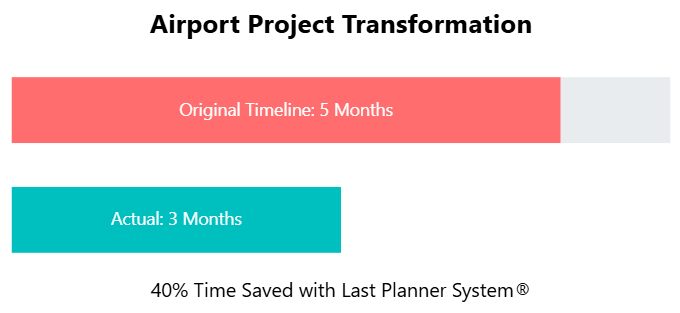
Teams using Lean practices consistently report:
- Projects completed up to 30% faster
- Significantly reduced waste and rework
- Improved stakeholder satisfaction
- Better team collaboration
- Higher profit margins
But perhaps most importantly, they’re seeing improvements in quality of life. One superintendent shared how, before adopting Lean, his weekends were consumed with administrative tasks like time card processing. After switching to a digital planning system, he no longer needed to spend Saturdays catching up – instead, he was able to coach his child’s soccer team. Lucky Superintendent. Very lucky kid.
Key Barriers to Success Adoption
Let’s be honest about why Lean adoption sometimes fails. It’s not because teams don’t want to improve – it’s often because we don’t address the real obstacles standing in their way.
The “I’ve Been Doing This for 30 Years” Challenge
Many superintendents and project managers have decades of experience managing projects successfully. Their most common reaction? “I’ve been doing this for 30 years. If we don’t finish on time, it’s usually because of things outside of my team’s control like design changes or supply chain issues. Why do I need this?”
Resistance to Lean can range from skepticism to outright refusal. In one case, a superintendent at a company that later embraced Lean was initially disengaged and dismissive, sitting with arms folded and offering short, indifferent responses during a small group introductory session.
For twenty minutes, the group discussed Lean’s benefits, but the superintendent remained unmoved. Sensing the resistance, the project manager took him aside for a private conversation. When they returned, something had shifted.
Though still unconvinced, the superintendent was at least willing to give it a try—a small but crucial first step.
This resistance often stems from a misunderstanding of Lean’s benefits. It’s not about replacing what works—it’s about making work easier. Lean reduces the stress of managing chaotic schedules, prevents 15-hour workdays, and eases the information gathering process. Once superintendents realize that Lean can improve their quality of life and job efficiency, they become more receptive.
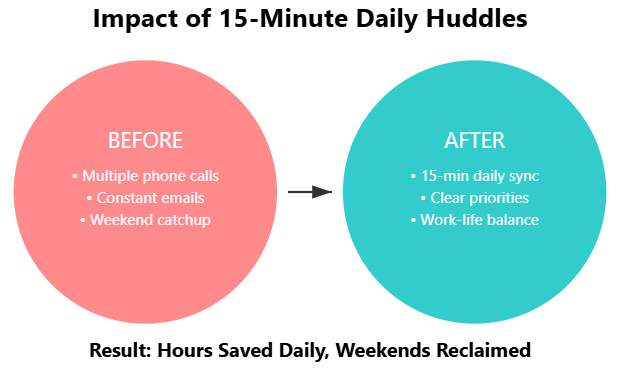
Leadership Commitment is Necessary
Here’s a common scenario: A project team gets excited about Lean, starts implementing changes, but the initiative never gains real traction. Why? Because true Lean adoption begins at the top. Leadership must see Lean as an investment that delivers measurable ROI, not just another operational change.
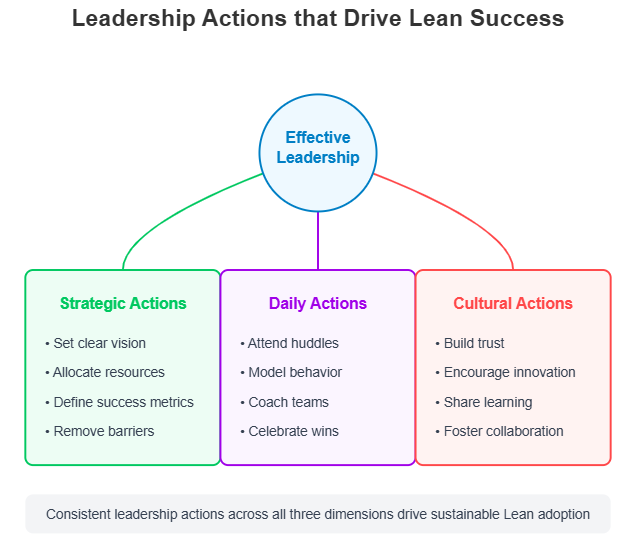
Executive support is most effectively gained through peer influence. Business leaders are more likely to trust the testimony of other executives who have successfully implemented Lean. Industry groups, case studies, and research from organizations like the Lean Construction Institute provide concrete data on cost savings and efficiency improvements. Executive understanding also grows through exposure in publications, industry events, and networking with leaders who have already embraced Lean.
Trade Partner Buy-In
Let’s address another common challenge: Trade partners often view Lean as additional work rather than a solution that makes their job easier. Many subcontractors have a “just let me do my job” mentality and initially resist collaborative planning methods like pull planning.
But here’s what changes their minds:
- Listening to their problems and frustrations with “traditional” scheduling
- Showing how pull planning eliminates scheduling conflicts and trade stacking
- Demonstrating how better coordination reduces rework
- Explaining how Lean practices lead to faster payments
- Providing clear evidence of improved workflow efficiency
The key is positioning Lean as a solution for trade partners rather than just another requirement from general contractors.
Trade partner buy-in is essential for Lean success, especially in complex projects involving multiple trades. Larger, sophisticated trade partners, such as mechanical, electrical, and plumbing contractors, are more likely to adopt Lean, while smaller-scale contractors may be slower to recognize its benefits.
The best way to gain trade partner support is through education and one-on-one engagement.
Technology Makes Adoption Easier
While some teams still rely on sticky notes and manual processes, digital Lean platforms are transforming how teams collaborate. But implementing technology requires a smart approach that bridges generational gaps.
Here’s an interesting dynamic we’ve observed: Many seasoned superintendents and project managers have decades of invaluable knowledge but may hesitate to adopt digital Lean solutions. Meanwhile, younger professionals are tech-savvy but need exposure to deep industry expertise.
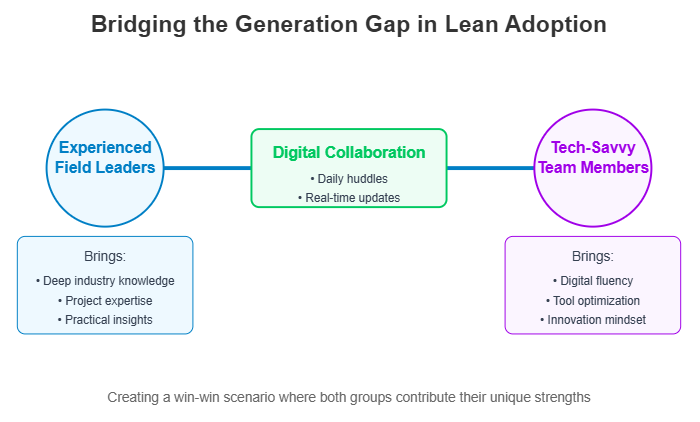
The solution? Creating partnerships where:
- Veterans share their deep industry expertise
- Younger team members help navigate digital platforms
- Both groups learn from each other’s strengths
- Technology becomes a bridge rather than a barrier
An example of overcoming technology adoption barriers in construction involved a seasoned worker who struggled to download an app. Frustrated and overwhelmed, he needed structured support to adapt to new technology. Project managers introduced several key strategies to address this challenge:
- Hands-on Coaching: Workers received direct, step-by-step guidance in a supportive setting.
- Pre-Mobilization Readiness Checks: A checklist confirmed access to required technology and basic usage skills before meetings.
- On-Site Learning Hubs: Scheduled sessions allowed workers to ask questions and get hands-on help when needed.
These efforts reduced anxiety, built confidence, and improved collaboration between experienced and newer team members.
Real-Time Collaboration Is Critical
Digital solutions like Touchplan, a construction planning and analytics platform that is used by leading Owners, Architects, Engineers, and Contractors to prevent schedule and budget overruns and gain visibility into real-time project insights, are changing the game by:
- Enabling virtual pull planning sessions that everyone can access even when not on site
- Supporting hybrid in-person/remote collaboration
- Maintaining real-time plan updates
- Creating permanent digital records
- Facilitating quick plan adjustments
In construction experience and innovation often clash. Overcoming this transition, leadership at a major construction firm implemented a tiered training strategy. This strategy included:
- Train engineers first – They master Touchplan’s technical functions and provide on-the-spot support without interfering in scheduling decisions.
- Gradually integrate superintendents – Hands-on guidance builds confidence without making them feel vulnerable.
- Make adoption a requirement – Contracts mandate Touchplan’s use, but one-on-one support and 2-way active listening ensure smooth implementation.
Introducing Lean planning platforms like Touchplan isn’t just about a new software solution, it’s also about changing mindsets. Many veteran superintendents resist technology, seeing it as unnecessary or disruptive. Younger team members, fluent in digital tools, struggle to bridge the communication gap. This disconnect slows progress, causing frustration and inefficiency.
To overcome this transition, leadership at a major construction firm implemented a tiered training strategy. This strategy included:
- Train engineers first – They master Touchplan’s technical functions and provide on-the-spot support without interfering in scheduling decisions.
- Gradually integrate superintendents – Hands-on guidance builds confidence without making them feel vulnerable.
- Make adoption a requirement – Contracts mandate Touchplan’s use, but one-on-one support ensures smooth implementation.
As teams gain confidence, resistance fades. Superintendents start mentoring younger engineers, while engineers help integrate technology into daily operations. Touchplan becomes the central hub for collaboration, ensuring all experience levels contribute effectively.
Touchplan also creates a cultural shift. In one company, before adopting Touchplan, trade teams worked in silos, limiting communication and collaboration. After adopting collaborative planning, a cultural shift emerged—electricians, pipefitters, and engineers began planning together, problem-solving, and exchanging ideas. This improved communication on-site, reducing conflicts and improving coordination. By breaking down barriers, the Touchplan-enabled Last Planner System fostered a culture of collaboration that extended beyond the job site, strengthening teamwork and efficiency.
How to Ensure Success in Lean Construction
The most successful Lean implementations begin with carefully selected demonstration projects.
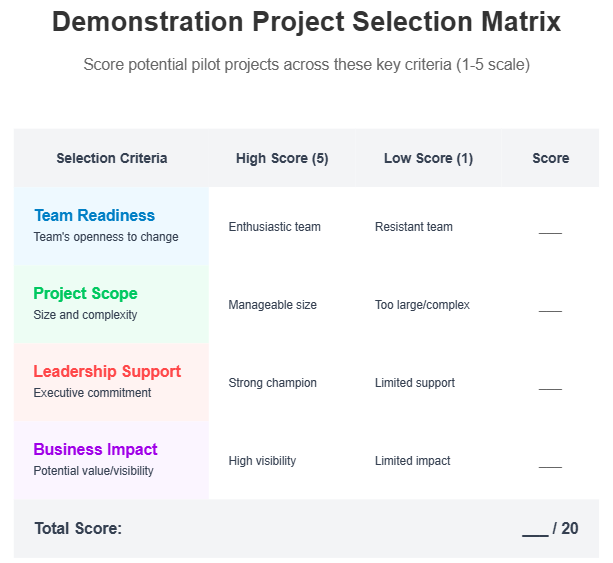
Here’s what to look for:
- Manageable scope and timeline (3-6 months ideal for demonstration projects)
- Engaged team members ready for change
- Clear opportunities for visible results
- Strong leadership support
- Defined success metrics
Create Feedback Loops That Matter
Success depends on establishing systems to capture and act on learning:
- Daily huddle insights that inform immediate adjustments
- Weekly progress reviews that identify trends coupled with Lookahead Make-Work-Ready planning for future weeks
- Monthly performance analysis that guides strategy – “managing to the Milestones”
- Quarterly assessments that ensure alignment
- Annual program evaluations that drive continuous improvement
The Six-Step Process to Successful Lean Adoption
While understanding the principles is crucial, having a structured implementation process is what separates successful Lean transformations from failed attempts. Here’s a proven six-step framework that organizations can follow:
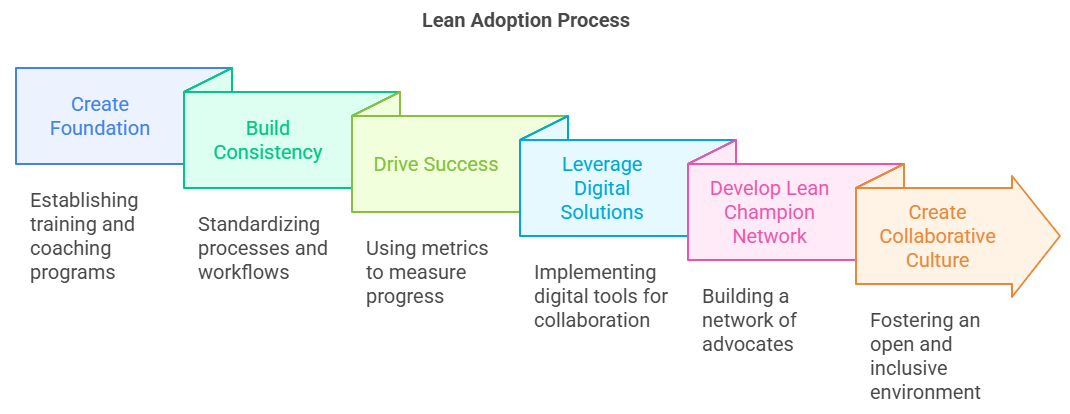
1. Create a Foundation Through Training & Coaching
Training isn’t just a one-time event—it’s an ongoing commitment to excellence. Successful organizations:
- Integrate Lean principles into new hire orientation including videos
- Provide regular access to experienced Lean coaches
- Make training mandatory, just like safety protocols
- Offer structured onboarding for both employees and trade partners
2. Build Consistency Through Standardization
Success comes from weaving Lean into daily operations, not treating it as a special initiative. Key actions include:
- Implementing daily 15-minute stand-up huddles
- Creating standard workflows that incorporate Lean principles
- Establishing clear accountability measures
- Regular reinforcement to prevent reverting to old habits
3. Drive Success Through Clear Metrics
Success in Lean adoption requires more than just implementation—it demands measurable results. Leading organizations:
- Track key performance indicators like schedule reliability, project cycle times and “managing to the Milestones”
- Share and discuss progress through accessible dashboards and regular reports
- Create transparency around waste reduction metrics
- Give teams clear visibility into their success rates and celebrate victories
- Use data to drive continuous improvement
4. Leverage Digital Solutions for Scale
While traditional Lean methods like sticky notes serve their purpose, but increasingly digital solutions are essential for modern construction environments. Effective digital adoption means:
- Implementing platforms that enhance real-time collaboration
- Providing hands-on training for all team members
- Using hybrid approaches that respect both traditional and digital preferences
- Measuring and sharing improved communication metrics
- Documenting efficiency gains through digital tools
5. Develop Your Lean Champion Network
Sustainable Lean adoption requires more than top-down mandates—it needs advocates at every level. Build your network by:
- Identifying and developing internal Lean champions
- Creating peer-to-peer learning opportunities
- Establishing mentorship programs
- Ensuring continuity when key team members transition
- Empowering teams to drive process improvements
6. Create an Open, Collaborative Culture
Perhaps most crucial is fostering an environment where different perspectives and experiences are valued. Success comes from:
- Pairing experienced field leaders with tech-savvy team members
- Creating mentorship opportunities that benefit both groups
- Recognizing and celebrating successful collaborations
- Building trust through shared successes
- Making technology adoption approachable for all skill levels
The Six-Step Process: Case Study
The power of this six-step process comes to life in real-world applications. When IPS tackled their ambitious biopharma facility project in North Carolina, they faced multiple challenges:
- Complex technical requirements of life sciences facilities
- Multiple trade partners requiring precise coordination
- Aggressive construction schedule demands
- Need for superior quality control
- Zero margin for error in specialized environments
By implementing this structured approach and leveraging Touchplan’s digital solutions, IPS:
- Reduced coordination meetings by 50%
- Enhanced stakeholder visibility across all project phases
- Minimized risk through proactive planning
- Improved trade partner engagement and a sense of mutual “ownership”
- Maintained schedule integrity despite complexity
The six-step process provides a clear roadmap, but each organization’s journey will be unique. The key is starting with a strong foundation and building systematically. Whether you’re just beginning your Lean journey or looking to enhance existing practices, focus on:
- Taking incremental steps toward full adoption
- Celebrating early wins to build momentum
- Learning from setbacks and adjusting approach
- Maintaining consistent leadership support
- Leveraging technology to scale success
Lean Adoption with Real-Time Collaboration Software
Structured Lean implementation isn’t just about reducing waste – it’s about creating a competitive edge in a rapidly evolving industry. When implemented correctly, Lean enables construction professionals to:
- Maintain better work-life balance
- Reduce unnecessary stress and overtime
- Focus on high-value activities
- Build stronger team relationships through mutual respect
- Deliver better project outcomes
Ready to Start Your Lean Journey?
The future of construction belongs to organizations that can adapt and improve. Whether you’re just starting to explore Lean or looking to enhance your existing implementation, the key is taking that first step.
Touchplan is proud to partner with leading Lean experts to advance industry improvements.
Sources:
[1] Lean Construction Practices and its Effects: A Case Study at St Olav’s Integrated Hospital, Norway
[2] True Cost of Project Delay
[3,4] Lean Construction
[5,6] Lean Construction Practices and its Effects: A Case Study at St Olav’s Integrated Hospital, Norway









